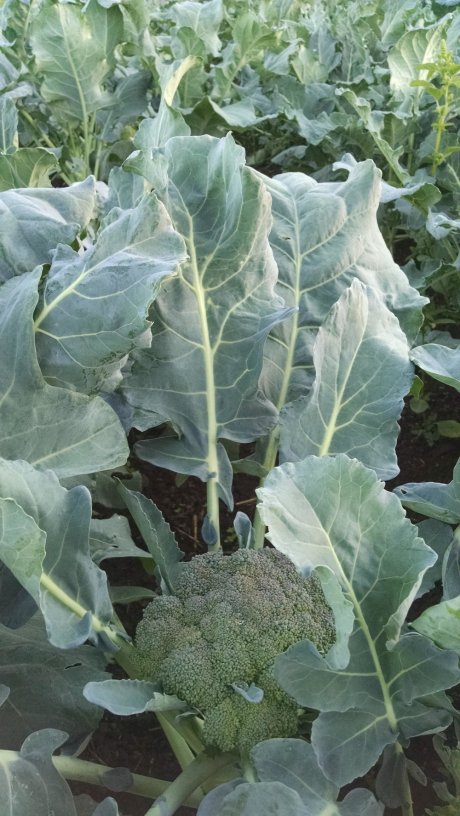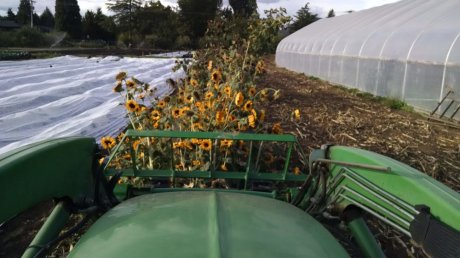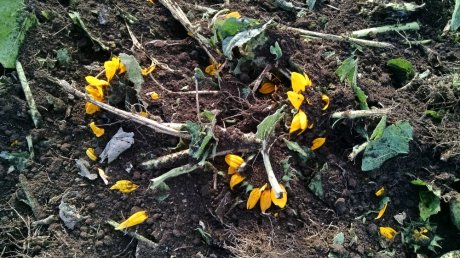It’s almost six o’clock in the evening already, light turned golden, farm quieted after a bustling day. It’s flown by, as they do. Harvest kept me completely consumed for the entirety of the day, in and out of the fields gathering raw produce, back and forth from wash tubs and sorting tables, showing people quality standards, spraying techniques, and bunch sizes. A group from Young’s Market Northwest joined us for the whole day, but mostly I was was Sophie and a few youth farmers to get everything processed and ready for tomorrow’s big Farm Fest market.
Often I don’t keep track of the things I bring in from the field, and up until now this summer I’ve been delegating most harvest to others. One group goes to get carrots and beets, another to the cucumbers and zucchini, and on and on until it all trickles in and I’ve twist-tied dozens of bunches and the coolers are full. Today, I kept at it, going out there myself to harvest crop after crop: salad mix and spinach first, then celery and the first flush of delicate, tender fall kale. Then another trip out to pull up our first crate of fall leeks— beautiful, pearly white stalks!— Swiss chard plucked from our newest patch that’s suddenly struck with mildew, and a smattering of broccoli— another first flush for the fall. They’re back!

First fall broccoli coming on
Bunching, washing, lunching, delegating, and a few hours later I’m back in the field to harvest eggplants and peppers: again, my first time in the outdoor pepper patch in weeks. The Jimmy Nardellos and Anaheims haven’t been touched this season yet, and I easily fill up a couple small crates to fill out the selection at the farm stand. Jalapeños, golden and red roasters, red and yellow bells, and a stunning collection of ripening purple peppers, which gradually turn to orange and red, leaving streaks of purple to really trip people out.
Meanwhile, David and a crew from the volunteer group have harvested tomatillos, apples, and the “cukes and zukes” en masse, Sophie’s bunched a tote of new basil, and at the end of the day she goes out with David to harvest corn and sunflowers.
They come back with a colorful cart of floppy flowers, setting aside dried heads to save for seed for their home gardens. Goodbyes, finish sorting apples, tidy up around the picnic tables, and before long it’s almost six o’clock in the evening already, and I’m starting out over the old bed of sunflowers where they got their seeds. It’s past its prime, dried and browning, but there are still bright flowers in the forest of stalks. Bees are buzzing through them. Birds are perching on and off the seed heads, pecking roughly to extract food.
I sigh, breathe in the scent of rain that still lingers over the fields, and put on the ear muffs.
Under the long pallet forks of the tractor, flower stalks fall and disappear. The loud hum overpowers any sounds that they’re making, but I imagine the crack and crash of giant fir trees as they hit the ground. I see Daddy Long-Legs scurrying away into neighboring beds at my side. I wonder about all the things that don’t have time to escape.

Tilling in the sunflowers
And behind me, as if the chaos and destruction of my foreground were just a dream, the soil lays dark and still, scattered with chopped flower heads, stalks, and a few bright petals. I think of the flowers that Sophie harvested from the newer patch just an hour ago. She’d commented on how they’re starting to fade, too— stalks thinner, droopier, flowers smaller.
They come, they sing, and they go.
I think of the gorgeous kale we harvested this morning. Baby fresh, just uncovered from the protection of row cover sheets, juicy and soft. And the mildew-coated Swiss chard I harvested later in the morning, that had been astoundingly big and perfect just a few weeks ago. It had been such a joy to harvest after weeks of harvesting similarly old, aphid-infested chard from older beds. I’d been shocked to see how quickly it had faded.
They come, they sing, and they go.
And there’s a period in between that no one likes to think about: that period when they’re fading, succumbing to pests or disease or simply old age, leaves thick and gnarly, defenses raised, bitterness overcoming sweetness in their tissues. It sounds like a bummer— and it can certainly feel like it sometimes, especially when it’s premature— but it’s just as much a part of this cycle as the freshy fresh tender baby time. I’ve celebrated the first tastes, first harvests, vibrant colors, bursting sweetness of summer for months now, and in many ways it’s a relief to lay attention on the decline, if only for a few minutes as I drag a tiller through an old bed of sunflowers in the dim evening light. Ashes to ashes, petals to petals, dust to dust.
Well hello, great Fall.

Sunflower petals reentering the earth
